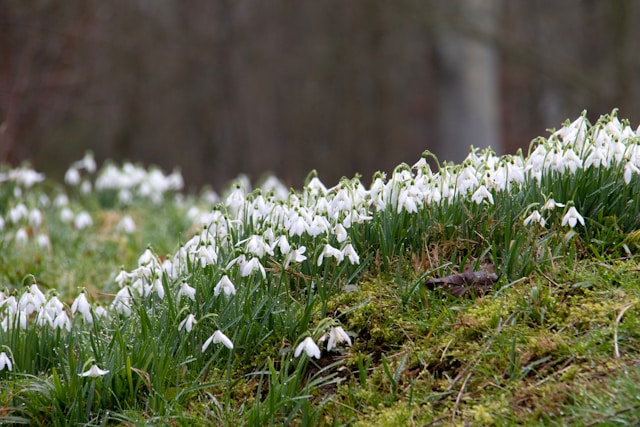Gardening is a favourite pastime for many, offering you the opportunity to relax and unwind in a natural environment while also remaining active and even employing a bit of creativity to the side. Yet, it is also associated with seasonality, and working in the garden is typically a spring and summer endeavour. That’s when everything is in full bloom and needs constant watering, some pruning and increased management. However, you also know that gardens are a lot of work and yield results weeks or even months after you’ve put in the effort.
You cultivate patience when you have a garden. As such, it shouldn’t come as a surprise that you can still do quite a lot of work in your garden during the winter months. Here’s everything you need to know.

Pruning
If you have roses in your garden, you should know that January and February are the best months to start pruning them. That’s because right afterwards, the first leaves will emerge. Depending on the type of roses you have, you need to employ different techniques. The older types should be pruned gently and carefully, but the modern varieties, referring to the breeds that emerged after 1867, are hardy and can be cut back more. Don’t be worried about how much you cut; if you haven’t removed all stems that are damaged or diseased, then you need to cut more.
It is also the perfect time to prune trees, as the lack of foliage allows you to see what you’re doing more clearly. Cutting during the warm season can mean you nip off more than necessary, causing you to do more harm than good. Sap is not active during wintertime either, so neither trees nor shrubs will feel the strength of the cut as much or be likely to “bleed”. With trees, you can even start a bit earlier, as they go dormant around November, a state that continues until March in most areas. During the winter, there are also no disease-carrying pests that can harm the more vulnerable trees.
Bring indoors
Many plants are sturdy enough to withstand the lower temperatures of the winter months, but some are more likely to be damaged and wilt. In these cases, the best way to get them through the winter is to bring them indoors. https://www.elho.com/en offers a wide range of designer flower pots built to fit the particular requirements of any plant. That way, when they’re ready to return to the outside when it becomes warm, the transfer won’t cause them any trouble. Jade plants, succulents, pothos, aglaonemas, dwarf citrus, orchids, and rubber plants are some of the best examples of plants that don’t do well in the cold.
For the ones that are larger or need to be moved regularly to get more sun or humidity, get a planter on wheels so that changing their spot won’t be a hassle. After all, you only want the best conditions for your greenery that will ensure the plants will be healthy and happy when spring arrives.
Wildlife
Many wildlife species visit your garden during the cold season, as the freezing temperatures and short daylight hours pose a challenge for animals who just want to find food, water and shelter. Habitat loss and the threat of climate change have also impacted the resilience of the animals. This winter, you could try to make their lives a little bit easier. The birds are the most obvious example. Throughout the cold months, they need a lot of energy to keep their bodies warm.
Seed mixes, fruit, millet and suet are the ideal choices since they’re loaded with calories that can sustain the birds. Hedgehogs enjoy meat-based wet food for cats and dogs. While you might be able to find special hedgehog food, it can be challenging to get the most nutritional options. Deer also requires supplemental feeding, with corn, acorns and oats being good protein sources for them. Squirrels will be glad to find walnuts, hazelnuts, chopped carrots, apples and grapes. There’s nothing as good as shrubs for wild rabbits and hares, but berries can also meet their nutritional needs.
Winter plants
While the winter months are traditionally associated with vegetation, there are several you can plant during these months that can bring more colour into your environment and make it livelier. Snowdrops are the best-known winter flowers. They bloom between January and March, and although they look very delicate, they are incredibly sturdy. They don’t need much care and attention, but they should get fresh compost every year during their dormant months, in late spring and summer.
Cyclamen can flower indoors and outdoors during the winter before going dormant during the summer. However, if the temperatures get very low where you live, you should consider getting them in pots and moving them inside. They aren’t resistant to frost and cannot survive if it gets really freezing. Make sure that it is sheltered away from the elements, particularly heavy rains.
Winter aconites will thrive in January and February, then retreat into the soil as the weather becomes warmer. The bulbs should be planted during autumn. Their brilliant, sunny colour will bring much-needed vibrancy during the cold, dreary days.
Ready for spring
Winter is a necessary step in the lives of the plants. The winter months are the best time to start preparing for spring. Think of the plants you want to integrate into your space and their specific needs so that you can come up with a layout. Designate particular areas for composting and storage. You can also start journaling for a more solid idea about the best times to start planting.
Wintertime is also the best moment to start propagating your perennials if you didn’t get the chance to do it in autumn. Catmint, hydrangeas, chrysanthemums, roses and mints are some of the most common examples. However, you should wait to do this when the weather starts becoming a little warmer, towards the end of winter, to avoid possible frosts.
Gardening is a year-long endeavour, and there’s always something you need to do. All the steps you take will yield results in the months to come.


